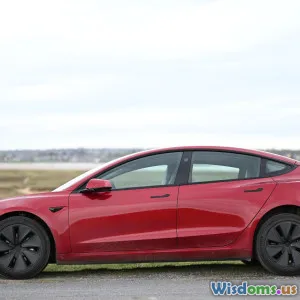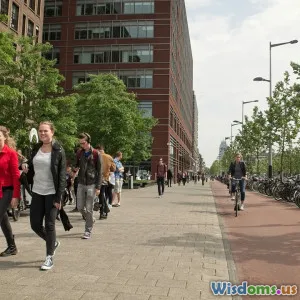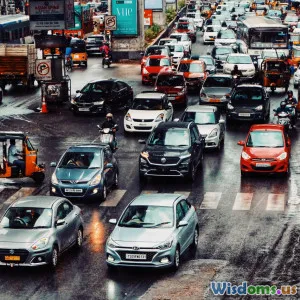
Ten Cities Leading Innovations in EcoFriendly Urban Transport
9 min read Explore ten cities pioneering eco-friendly urban transport through innovative solutions transforming how people move sustainably. (0 Reviews)
Ten Cities Leading Innovations in Eco-Friendly Urban Transport
Urban transport stands at the crossroads of environmental urgency and technological potential. As more than half of the world’s population now lives in urban areas, the design of city transport systems significantly impacts global carbon emissions and quality of life. The challenge: how can cities innovate to reduce pollution, improve accessibility, and promote sustainability? This article dives into ten trailblazing cities setting benchmarks in eco-friendly urban transport innovations, offering insights that inspire a cleaner, smarter, and greener future.
1. Amsterdam, Netherlands – The Capital of Cycling Culture and Electric Mobility
Often referred to as the 'Bike Capital of the World,' Amsterdam's commitment to bicycles is legendary. However, their eco-friendly innovation goes beyond traditional cycling. The city has embraced electric bikes (e-bikes) with vast charging infrastructure, reducing reliance on cars even further.
The city integrates solar-powered charging stations and incentivizes electric vehicle (EV) use, complemented by expansive networks of bike lanes. Amsterdam's ‘Smart Cycling’ project uses sensors and data analytics to optimize bike traffic flow and enhance safety.
Fact: Approximately 63% of trips in Amsterdam are made by bike, one of the highest in the world.
2. Copenhagen, Denmark – Pioneering Carbon-Neutral Transport
Copenhagen aims to become carbon-neutral by 2025, a vision closely tied to its smart transport initiatives. The city’s infrastructure supports over 390 kilometers of dedicated bike lanes, with smart traffic signals prioritizing cyclists and buses.
Copenhagen’s extensive fleet of electric buses complements its bike-centric policies. Additionally, the city deploys hydrogen fuel cell buses as a pilot project, which only emit water vapor.
Quote: Mayor Frank Jensen stated, “Copenhagen’s ambition is not just to reduce emissions but to reinvent the way we move in the city.”
3. Singapore – Smart Urban Mobility Powered by Technology
Singapore leverages advanced technology to reduce congestion and enhance sustainability. Its intelligent transport system employs real-time traffic analytics, adaptive traffic lights, and electronic road pricing to discourage private car use during peak hours.
The city-state promotes electric car adoption with widespread fast-charging stations and incentivizes shared autonomous vehicles. Singapore’s urban planners have tightly integrated public transport networks, including buses and an extensive metro system, optimized for energy efficiency.
Insight: Singapore’s ‘Green Plan 2030’ outlines targets for significantly increasing the number of EVs and expanding green transport options.
4. Helsinki, Finland – The MaaS Pioneer
Helsinki is the birthplace of Mobility as a Service (MaaS), an innovative platform integrating different modes of transport—such as buses, trams, bikes, taxis—into a single, accessible app.
Citizens can plan and pay for entire trips via smartphones, dramatically reducing car dependency. Public transport vehicles in Helsinki are increasingly hybrid or electric, and experimental autonomous electric buses operate on designated routes.
Data-driven transport planning ensures resources adapt to demand, improving efficiency and lowering emissions.
5. Los Angeles, USA – Transitioning to Clean Public Transit
Though known for car culture, Los Angeles is transforming its transit landscape, aggressively investing in zero-emission buses and expanding bike-share programs.
LA Metro plans to have an all-electric bus fleet by 2030, comprising hundreds of battery-electric and hydrogen fuel cell buses. The city also introduces protected bike lanes and smart traffic systems to enhance non-car commutes.
Fact: The city’s e-scooter pilot program in 2022 resulted in a 12% increase in shared micro-mobility trips.
6. Shenzhen, China – World’s First Fully Electric Bus Fleet
Shenzhen made headlines becoming the first city in the world with a fully electrified public bus system. Over 16,000 electric buses significantly reduce air pollution in this megacity.
Beyond buses, Shenzhen promotes electric taxis, and invested heavily in charging infrastructure. The scale of deployment provides a valuable global model for other cities tackling urban pollution.
Data: Studies estimate that Shenzhen’s electric bus transition prevents around 1.35 million tons of CO₂ emissions annually.
7. Curitiba, Brazil – The Bus Rapid Transit Innovator
Curitiba pioneered Bus Rapid Transit (BRT) systems that combine the efficiency of subways with the affordability of buses. This approach minimizes emissions by optimizing bus routes with dedicated lanes and priority signaling.
The city integrates green corridors alongside the BRT, promoting walkability. Its BRT system inspired similar innovations worldwide and remains a benchmark for eco-friendly mass transit.
8. Vancouver, Canada – Green Streets and Electric Ferries
Vancouver’s multi-modal strategies integrate green streets, encouraging walking, cycling, and electric public transport. Alongside extensive bike infrastructure, the city has introduced electric ferries, reducing diesel emissions in busy waterways.
Vancouver’s policies support renewable energy use, with many transit hubs equipped with solar panels and energy-efficient lighting.
Quote: “Investing in green transport is investing in our community’s health and economic vitality,” says Vancouver’s transportation chief.
9. Paris, France – Pedestrianizing and Electrifying Urban Mobility
Paris aggressively promotes walking, cycling, and electric transport. The city’s Vélib’ bike-sharing program is one of the largest globally, constantly expanding its fleet of e-bikes and electric scooters.
Congestion zones restrict internal combustion vehicles, while accessible EV charging stations facilitate a cleaner fleet. Paris offers free bicycles and electric scooters around the clock, increasing accessibility.
Example: Paris’s ‘15-minute city’ urban design aims to ensure all amenities lie within a walking or cycling distance, reducing unnecessary car trips.
10. Melbourne, Australia – Smart Integration of Public and Micro-Mobility
Melbourne exemplifies the synergy of public transit and micro-mobility solutions. The city enhances tram and bus services with strategic micro-mobility hubs featuring bike-share and electric scooter options.
Innovations such as solar-powered tram stops, smart ticketing, and real-time transport data empower passengers to choose sustainable modes seamlessly.
Data: Surveys showed a 20% increase in public transport and micro-mobility adoption after these innovations launched.
Conclusion: Blueprint for the Future of Urban Movement
The global momentum toward greener, smarter urban transport is palpable. Cities highlighted here demonstrate that with strategic planning, technology, and community engagement, barriers to sustainability can be overcome.
Whether it’s Amsterdam’s cycling culture, Shenzhen’s electrified fleets, or Helsinki’s MaaS innovation, each offers valuable lessons. Policymakers, urban planners, and citizens alike can draw inspiration from these dynamic examples to foster eco-friendly transport systems that protect the planet and enhance urban life.
Ultimately, innovation fueled by conscious purpose, backed by data and inclusive community frameworks, will drive the transformation to sustainable urban mobility worldwide.
References:
- International Energy Agency (IEA) Mobility Reports
- C40 Cities Climate Leadership Group Publications
- City government sustainability plans
- Academic journals on urban planning and transport
Author’s Note: This article seeks to empower readers with insights and actionable inspiration to advocate for and embrace eco-friendly urban transport trends globally.
Rate the Post
User Reviews
Popular Posts




















